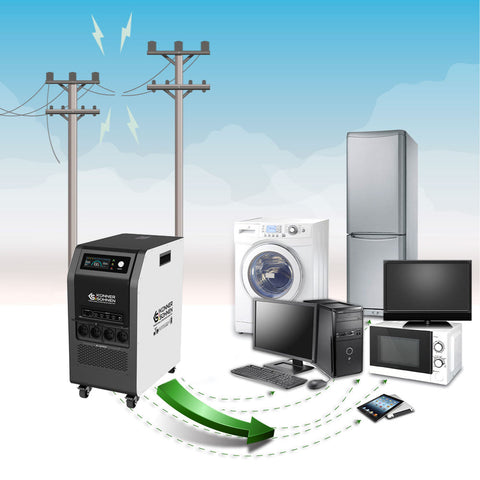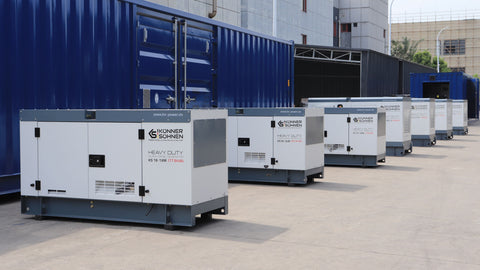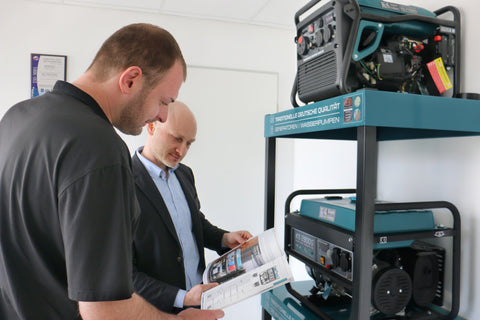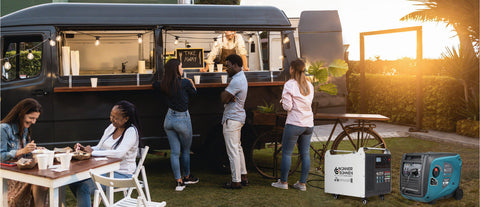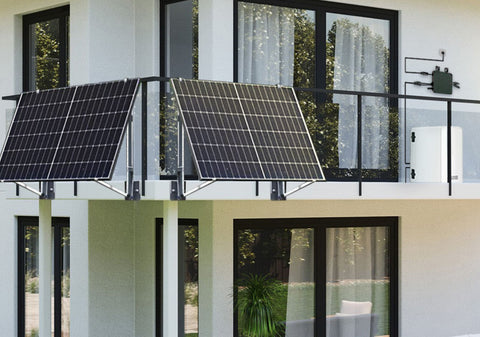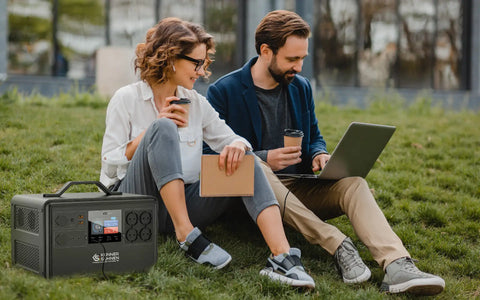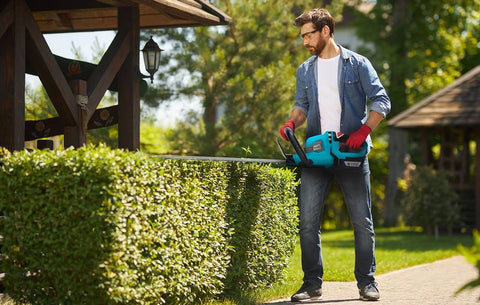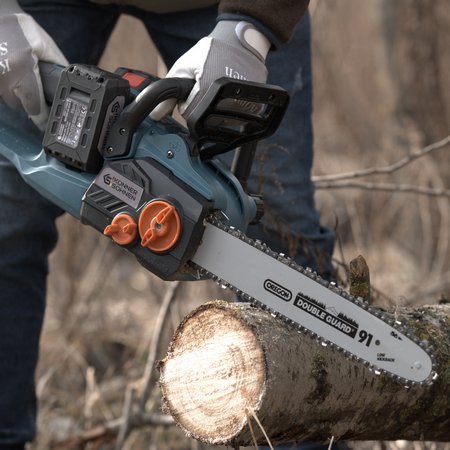Inverter generators are designed as IT systems and have basic protection through basic insulation of the live parts. The PE pins in the sockets are connected to the body of the generator in the same way as the grounding screw. The two active contacts in the sockets are equivalent as long as neither is grounded.
Emergency power supplies in buildings must generally be implemented as a TN system. In this case, the generator and its neutral conductor must be earthed. The earthing screw on the generator must be connected to the main earthing bar in the building using a 6-10 mm² copper cable. Alternatively, a separate earthing system can be built for the generator. The PE conductor from the socket on the generator goes to the earthing screw in the distribution box, which in turn must be connected to the main earthing bar. The N conductor from the generator's CEE socket must be earthed at the connection point in the distribution box. This can be done by placing a bridge between N and PE on the generator side of the transfer switch.
Inverter generators from Könner & Söhnen deliver 230V and, provided the rated and maximum power are observed, can be used for 230V household feed-in. This allows them to supply almost all household electricity consumers.
Do my electrical appliances need 230V or 400V ?
400V three-phase current is generally only needed by devices that require a rotating field. These are power consumers with three-phase motors, such as tools, pumps, etc.
Such electricity consumers as the electric stove, powerful instantaneous water heater, fan heater, electric boiler or sauna are connected to 3-phase only for the purpose of load distribution in the DNB network and are in fact 230V electricity consumers that can be supplied by a 230V generator.
230V power consumers with a total power of more than 4.6 kVA must be connected to 3 phases for load distribution when operating from the external power grid. In emergency power operation, when using a non-unbalanced load emergency power generator, they must be supplied with 230V, but must not be brought to full power to avoid overloading the neutral conductor.
Power consumers such as electric stoves are typically connected with a 5 x 2.5 mm² copper cable. Thus, when powered by the generator, a pair of cooktops, or a cooktop and an electric oven, can be operated without any problems without overloading the neutral conductor of the supply cable. Provided the generator itself has sufficient power. The same applies to instantaneous water heaters, fan heaters, electric boilers, saunas, etc., which have internal 230V heating elements and are, in fact, 230V power consumers.
In conventional generators (also with AVR), the current is taken from the winding of the alternator and the shape of the voltage can be different depending on the design of the generator.
The voltage frequency of a conventional synchronous generator is determined by the motor speed, which can fluctuate depending on the load. The AVR controls the effective voltage, but not the voltage waveform, and for sensitive power consumers, the voltage waveform is particularly important.
In inverter generators, the voltage is generated electronically and has a much more stable shape and parameters and these are recommended for sensitive power consumers such as electronic devices, LED lighting, etc.
Comparison of voltage (yellow) and current (green) of an inverter and a conventional generator under electronic load (electronic device with switching power supply):

Inverter generator

Conventional generator
Conventional generators (even with AVR) experience significant distortion under non-linear loads.
You can find out whether the respective electronic device can be supplied with a conventional generator or whether it absolutely requires an inverter voltage from the manufacturer of the device, because only the manufacturer knows exactly how his device is constructed and how it reacts to distortions in the voltage waveform.
Here is the recommended connection plan for a house feed-in according to the VDN guideline for the planning, construction and operation of systems with emergency power generators:

Emergency power with a 1-phase house connection:

The neutral and ground conductors from the generator must be bridged at the transfer switch. This creates a TN system with the grounded neutral conductor on the generator side.
Operating the generator with bridged neutral and PE conductors without grounding is prohibited for personal safety reasons. If this is missing (e.g., with a TT external grid connection), a separate grounding system must be installed for the generator. The generator's neutral conductor must be grounded similarly to the neutral conductor on the transformer station side of the public power grid to ensure emergency power supply in the TN system.
Emergency power for house with 230V feed-in socket on the outside wall:

This connection option requires much less effort than a permanent installation of the generator, which has only advantages in the case of rare power outages.
A transfer switch is installed in the house's distribution board, and a TN system is constructed on the generator side (bridge between N and PE). In the event of a short circuit (L against the power consumer housing), the current flows via the bridge from PE to N, and the circuit breaker on the generator trips. The generator's grounding screw must be connected either to the house's ground via the pre-installed fixed grounding point or to a specially constructed grounding system. The generator can be connected to the feed-in box using a standard extension cable (suitable for the socket type). No permanent installation is required; the generator is only used in the event of a power outage and can be connected at any time without great effort.
The second, free Schuko socket (models with 2 sockets) receives the earthed neutral conductor immediately after the connection cable from the first socket to the feed-in socket is connected, since the two sockets on the generator are connected in parallel.
Generators with an ATS connection can also be started and stopped automatically using a suitable ATS box.
The ATS monitors the voltage on the "City power" side of phase L1 and automatically starts the generator in "Auto" mode as soon as the voltage is lost. After the generator starts, its voltage is checked, and only then is the power supply to the emergency power-enabled consumers switched to the generator side. When the voltage returns to the "City power" side, the "Load output" is switched to the "City power" side, and the generator is stopped.
The grid separation is carried out safely and across all poles and the neutral conductor from the generator must be earthed at the ATS (bridge between N and PE) so that the emergency power feed-in takes place in the same system (TN or TT) as from the external power grid.
Recommended connection plan for a house feed-in according to the VDN guideline for the planning, construction and operation of systems with emergency power generators for the model KS 8100iE ATSR with KS ATS 4/25 Gasoline Box:

In this variant, electricity consumers entitled to emergency power can be supplied with power from the external power grid with up to 25A (per phase line) and from the generator with up to 25A (total).
Recommended connection plan for a house feed-in according to the VDN guidelines for the planning, construction and operation of systems with emergency power generators for the model KS 5500iE ATSR with KS ATS 4/25 Inverter Box:

If the current requirement (when operating from the external power grid) is higher than 25A per phase, an additional load transfer switch must be used:

In this variant, consumers authorized to use emergency power can be supplied with power from the external grid according to the load transfer switch used and from the generator up to a total of 32 A. The rated current of the LSS 2 should correspond to the power requirements of consumers authorized to use emergency power permanently.
Recommended connection plan for 1-phase house connection:

In this variant, electricity consumers entitled to emergency power can be supplied with power up to 50A from the external power grid and up to 32A from the generator.
Inverter generators from Könner & Söhnen are equipped with electronic overload protection. If this is triggered, you must disconnect the excess load and press the "AC Reset" button to restore power.
The two sockets, CEE 230V 32A and Schuko, are connected in parallel. The PE contacts of both sockets are connected to the generator housing and to the grounding screw.

Electronic overload and short-circuit protection is built into the inverter module.
However, this protection does not protect the inverter module itself if, for example, the generator is connected in parallel to other power sources or if it supplies power consumers that are able to send energy towards the generator, e.g. through self-induction, built-in electronic brake, etc.
Our generators are emergency power generators and are not suitable for continuous, uninterrupted operation.
We recommend running all of our gasoline generators for up to 5 hours, but then taking a break of 30-60 minutes to cool down.
The ECO mode of the inverter generator should only be used for lower loads. The motor then has a lower speed and the capacitors in the inverter module have a lower DC voltage and correspondingly less stored energy, which can lead to voltage drops or distortion in the sine wave output voltage of the inverter module if, for example, 1-2 kW of load is switched on at once. The motor needs a certain amount of time to reach a higher speed in order to provide sufficient energy for the inverter module. In normal mode, the capacitors in the inverter module maintain a higher DC voltage so that they have more stored energy for generating the 230V output voltage and can therefore better cope with higher loads that are switched on. The motor also reaches a higher speed in ECO mode in order to provide sufficient energy and at higher loads there is hardly any difference between ECO and NORMAL. However, if you switch a powerful load on or off suddenly in ECO mode, this can lead to malfunctions caused by insufficient energy in the capacitors when the load increases quickly or by a voltage on the capacitors that is too high for ECO mode when the load is switched off, because the motor needs a certain amount of time to adjust its speed to the load to be supplied.
Important!
A generator cannot be used as a replacement for the public grid without taking into account the existing system and its components, since a generator itself represents a separate power source whose characteristics are different from the DSO grid.
The generator must not be connected in parallel to an on-grid (grid-tie) inverter or other power sources.
Disclaimer:
This manual is intended only as a guide, is illustrative, and must be adapted to the specific circumstances and conditions on site during installation. The installation itself must be carried out in compliance with all standards and regulations. We assume no responsibility for incorrect installations and their consequences.

